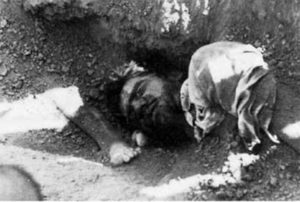Crime Against Humanity: 1988 massacre of political prisoners in Iran
Aug 25th, 2018A short video documentary about the 1988 massacre of political prisoners in Iran
—————————————————————–
In February 1979 the ruling monarchy in Iran was toppled and while the nation’s democratic and secular movements were weak, Ayatollah Khomeini, and a ring of clergymen attached to him, seized control of the country. From the onset, the new regime sought to forcefully impose a fundamentalist interpretation of Islam. But the Iranian society, which yearned for democracy and prosperity was a serious obstacles to Khomeini’s objectives. So, in order to consolidate its power, the new regime turned to the brutal repression of political and civil liberties.
Regime’s first target were the women. A war on women’s rights was waged and compulsory veiling was gradually imposed. Since universities were the fortress of resistance to theocratic retrogression, the regime launched “Cultural Revolution,” during which the regime’s armed gangs raided universities, rounded up activists, purged the staff, and killed dozens in order to eradicate or silence all opposition. Universities across Iran were closed for nearly two years.
As the Iranian society refused to be intimidated and continued to oppose the regime. Khomeini turned to all-out repression. On June 21st, 1981, Khomeini ousted the elected president and his security forces opened fire on peaceful demonstrators killing tens of people.
From that day onward, the daily execution of dozens and later hundreds of prisoners across the country ushered in the age of the mullahs’ severe and barbaric repression in Iran. Between 1981 and 1988, tens of thousands of opponents from across the political spectrum were arrested, tortured and many of them executed.
Then, the summer of 1988 arrived. For months, the Iranian regime’s war with Iraq, which had started in 1980, had reached a critical deadlock. The regime had suffered heavy losses and thus prepared the grounds for announcing a ceasefire. Due to political and social consequences of its defeat in the war, the regime was preparing the massacre of political prisoners in order to eradicate all opposition to its weakening rule.
On July 19th, 1988, Khomeini accepted a truce to end the war and shortly thereafter ordered the massacre of political prisoners. He set up an official Commission comprising prison and judicial authorities to decide on the fate of prisoners. Known as the “Death Commission”, its first targets were members of the People’s Mojahedin Organization known as MEK.
Following Khomeini’s order, the death commission interviewed each prisoner. The prisoners who showed the slightest sympathy to MEK or did not repent, were sent to the gallows.
A good portion of these prisoners had been in prison for many years and none had been sentenced to death. Many of them had already served their terms and others had a few days or months left.
In his letters to judicial authorities, Khomeini warned against the slightest measure of flexibility or indulgence and urged a speedy process of executions.
The sheer scale of this crime against humanity was so vast that Ayatollah Hossein-Ali Montazeri, Khomeini’s designated successor at the time, sent two letters to Khomeini to protest to the massacre. He was consequently dismissed as Khomeini’s successor and was put under house arrest.
While the execution of MEK supporters was continuing unabated, Khomeini issued a new fatwa to execute secular political prisoners belonging to other groups as well. As a result, many of them were hanged.
The actual number of prisoners who were executed in this horrendous crime against humanity and many of their graves are still unknown. Some of the victims were buried in mass graves in cemeteries like Khavaran near Tehran.
Last year, Mohammad Nouri-Zad, a pro-regime filmmaker and trusted journalist who in 2009 became a critic of the regime’s policies, declared that the number of those executed in the massacre were thirty-three thousand. He added:
“Here, two or three months, thirty-three thousand prisoners, boys and girls, men and women were executed, and their bodies were dumped into mass graves of Khavaran and unknown places in the desert.”
The regime’s senior figures have all been complicit to this vast crime against humanity. 27 years after its occurrence, the real dimensions of this horrific crime are still clouded in secrecy. Mostafa Pour-Mohammadi, one of the notorious member of the Death Commission, is now Minister of Justice in Hassan Rouhani’s cabinet.


